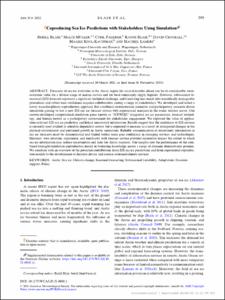| dc.contributor.author | Blair, Berill | |
| dc.contributor.author | Mueller, Malte | |
| dc.contributor.author | Palerme, Cyril | |
| dc.contributor.author | Blair, Rayne | |
| dc.contributor.author | Crookall, David | |
| dc.contributor.author | Knol-Kauffman, Maaike | |
| dc.contributor.author | Lamers, Machiel | |
| dc.coverage.spatial | Arctic Region | en_US |
| dc.date.accessioned | 2023-05-10T16:10:13Z | |
| dc.date.available | 2023-05-10T16:10:13Z | |
| dc.date.issued | 2022 | |
| dc.identifier.citation | Blair, B., Müller, M., Palerme, C., Blair, R., Crookall, D., Knol-Kauffman, M. and Lamers, M. (2022) Coproducing Sea Ice Predictions with Stakeholders using Simulation. Weather, Climate, and Society, 14, pp.399–413. DOI: https://doi.org/10.1175/WCAS-D-21-0048.1 | en_US |
| dc.identifier.uri | https://repository.oceanbestpractices.org/handle/11329/2205 | |
| dc.description.abstract | Forecasts of sea ice evolution in the Arctic region for several months ahead can be of considerable socioeconomic value for a diverse range of marine sectors and for local community supply logistics. However, subseasonal-to-seasonal (S2S) forecasts represent a significant technical challenge, and translating user needs into scientifically manageable procedures and robust user confidence requires collaboration among a range of stakeholders. We developed and tested a novel, transdisciplinary coproduction approach that combined socioeconomic scenarios and participatory, research-driven simulation gaming to test a new S2S sea ice forecast system with experienced mariners in the cruise tourism sector. Our custom-developed computerized simulation game known as ICEWISE integrated sea ice parameters, forecast technology, and human factors as a participatory environment for stakeholder engagement. We explored the value of applications-relevant S2S sea ice prediction and linked uncertainty information. Results suggest that the usefulness of S2S services is currently most evident in schedule-dependent sectors but is expected to increase as a result of anticipated changes in the physical environment and continued growth in Arctic operations. Reliable communication of uncertainty information in sea ice forecasts must be demonstrated and trialed before users gain confidence in emerging services and technologies. Mariners' own intuition, experience, and familiarity with forecast service provider reputation impact the extent to which sea ice information may reduce uncertainties and risks for Arctic mariners. Our insights into the performance of the combined foresight/simulation coproduction model in brokering knowledge across a range of domains demonstrates promise. We conclude with an overview of the potential contributions from S2S sea ice predictions and from experiential coproduction models to the development of decision-driven and science-informed climate services. | en_US |
| dc.language.iso | en | en_US |
| dc.rights | Attribution 4.0 International | * |
| dc.rights.uri | http://creativecommons.org/licenses/by/4.0/ | * |
| dc.subject.other | Seasonal forecasting | en_US |
| dc.subject.other | Subseasonal variability | en_US |
| dc.subject.other | Serious games | en_US |
| dc.subject.other | Sea Ice | en_US |
| dc.subject.other | Gaming | en_US |
| dc.title | Coproducing Sea Ice Predictions with Stakeholders Using Simulation. | en_US |
| dc.type | Journal Contribution | en_US |
| dc.description.refereed | Refereed | en_US |
| dc.format.pagerange | pp.399-413 | en_US |
| dc.identifier.doi | http://dx.doi.org/10.1175/WCAS-D-21-0048.1 | |
| dc.subject.parameterDiscipline | Human activity | en_US |
| dc.subject.dmProcesses | Data visualization | en_US |
| dc.bibliographicCitation.title | Weather Climate and Society | en_US |
| dc.bibliographicCitation.volume | 14 | en_US |
| dc.description.sdg | 14.2 | en_US |
| dc.description.methodologyType | Reports with methodological relevance | en_US |
| obps.contact.contactname | Berill Blair | |
| obps.contact.contactorcid | Blair, Berill/0000-0002-3298-9816 | |
| obps.resourceurl.publisher | https://journals.ametsoc.org/view/journals/wcas/14/2/WCAS-D-21-0048.1.xml | |
 Repository of community practices in Ocean Research, Applications and Data/Information Management
Repository of community practices in Ocean Research, Applications and Data/Information Management

